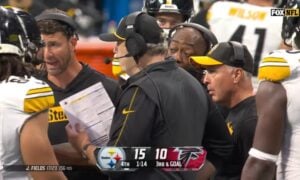Last week, Andy Benoit of Monday Morning Quarterback posted an article entitled “Time for a New Approach in Pittsburgh?”, regarding the team’s draft strategy, particularly since general manager Kevin Colbert has been in charge.
He writes in the article that “the most interesting team to watch in this year’s draft will be the Steelers. Come the second week of May, it will be fascinating to see what GM Kevin Colbert and coach Mike Tomlin tell us about their club”.
The reason? To see if they shift their draft philosophy after back-to-back non-playoff seasons, the first such instance in the Colbert era. In Benoit’s words:
For the longest time, the Steelers have had the perfect draft model. They filled holes two or three years in advance, so rookies (even first-round picks) often learned the ropes from the second string. This works when you have good assistant coaches; young players are able to develop under teachers like linebackers coach Keith Butler and secondary coach Carnell Lake, who both work under legendary defensive coordinator Dick LeBeau.
Since taking over Pittsburgh’s football operations in 2000, Colbert has drafted 42 players in the first three rounds, with 32 eventually becoming starters. Of those 32, however, only 11 started at least half of the games as rookies.
Despite this shrewd model, the Steelers are coming off a second straight 8-8 disappointment. Only twice in the previous dozen years under Colbert had they failed to post a winning record. Will he and Tomlin be less patient and draft players to fill immediate needs?
The postulation, then, is that the Steelers should consider placing greater emphasis than in the past on team needs when making their draft selections, and in turn getting those selections on the field and in the starting lineup more quickly.
Team president Art Rooney II has publicly commented on the latter in years past, expressing a desire to get the team’s young players up to speed and contributing more quickly. 2013 certainly saw a lot of contributions from rookies.
But the truth of the matter is that no team ever truly drafts the best player available, and rarely do teams ever explicitly and exclusively target positions in order of need. Benoit suggests that David DeCastro and Le’Veon Bell represent draft picks based on need that the Steelers have made in recent years, but is this accurate?
In 2012, the Steelers still had Ramon Foster and Doug Legursky at guard, and would also move Willie Colon to guard as well. Guard wasn’t explicitly a need, but DeCastro was chosen because he was such a high prospect that it was surprising he was available.
Running back, on the other hand, was obviously a clear need, but need and BPA are not incompatible, and it would be hard to argue that Bell wasn’t a strong mid-second-round draft pick. While he filled a need for the team, it certainly wasn’t a reach.
This year, the Steelers’ top needs appear to be cornerback, defensive end, and wide receiver. One can argue that they don’t have a number two receiver or a second starting defensive end. By Benoit’s premise, Pittsburgh’s first pick should inevitably be one of these two positions.
Given where the Steelers find themselves (e.g. back-to-back 8-8 records), should the Steelers put greater emphasis on need in their selections? Is there a fundamental flaw in their draft procedures that needs to be revised, or have they just had some bad luck in recent years? Is it time to start thinking about changing their approach?







